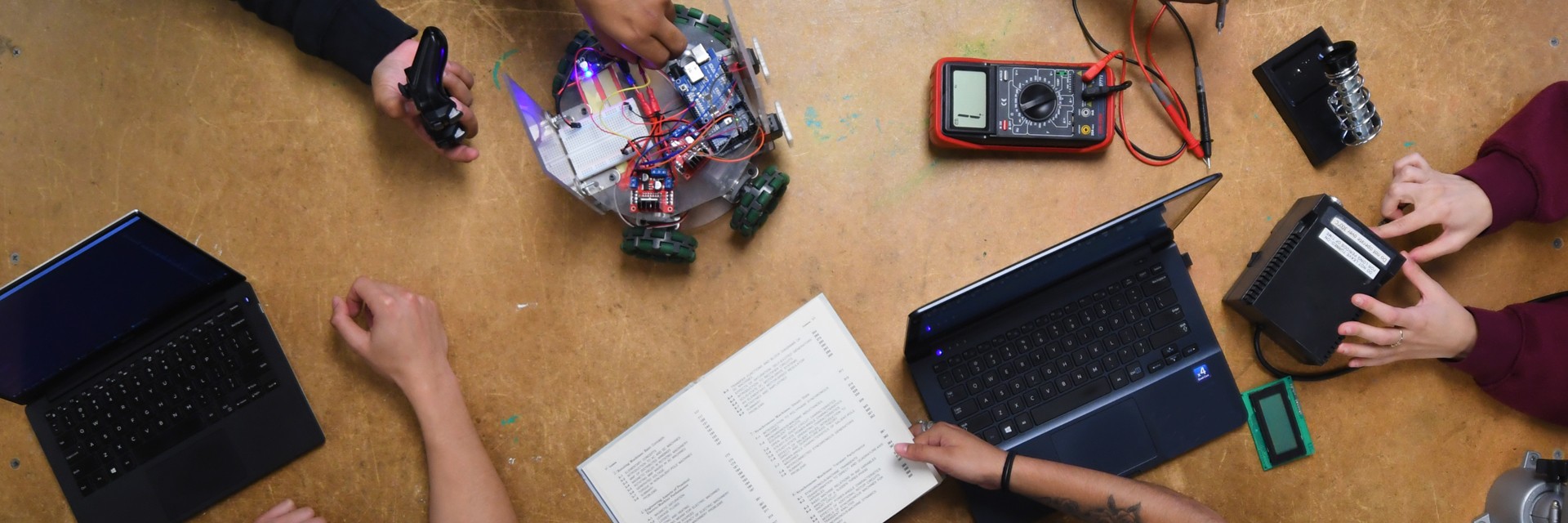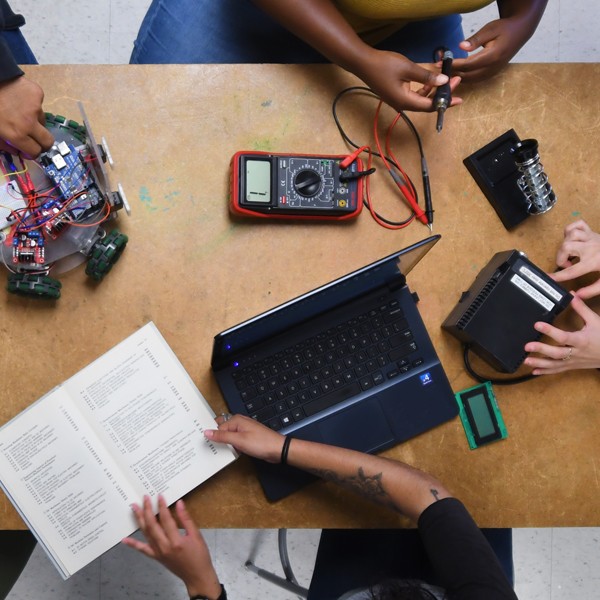Solar Eagle III is the third chapter in Cal State L.A.'s exciting trilogy of solar-powered electric vehicle design projects. Engineered by students under the guidance of faculty and staff, the Solar Eagle III represents the culmination of learning, trial and redesign gleaned from the University's first two solar race cars, the Solar Eagle and the Solar Eagle II.
On Saturday, June 28, 1997, the Solar Eagle III won the prestigious Sunrayce 97, the national intercollegiate solar car race, crossing the Colorado Springs finish line under fittingly sunny skies. Setting a Sunrayce record for average speed of 43.29 mph, Cal State L.A. finished nearly 20 minutes ahead of second-place Massachusetts Institute of Technology (MIT). The combined team of Stanford University/UC Berkeley finished third. Texas A&M, whose team used the molds from Cal State L.A.'s Solar Eagle II to build their entry, the MACH V, finished fourth.
Solar Eagle III's first-place finish at Colorado Springs marked the end of ten days of exciting intercollegiate solar car racing. Throughout the competition, Cal State L.A., MIT and Stanford/ UC Berkeley jockeyed in the top three positions. In the end, good design and solid engineering won the race: the beautifully-built Solar Eagle III never broke down during the entire 1,230 mile course the only competitor in the Sunrayce to earn this distinction. (The car never even had a flat tire.)
The Solar Eagle III's technical specifications, described below, give the blueprint for a national champion — a world-class, space-age solar vehicle, meticulously refined and built on the successes of its first two solar cars, Solar Eagle and Solar Eagle II.
Technical Specifications
- Weight: 427 pounds (without driver and batteries)
- Length: 19.2 feet
- Width: 6.3 feet
- Height: 3.1 feet
- Rolling Chassis: carbon fiber monocoque structure
- Body and Solar Panel: carbon fiber skin with Nomex honeycomb core Solar Cells: 762 terrestrial grade silicon cells (4.05" x 3.94") by Siemens wired in four parallel strings
- Panel Voltage: 85-volts peak string voltage
- Tire Rolling Resistance: .0045
- Drag Coefficient: .15
- Wheel Base: 104 inches
- Wheels and Tires: wheels have composite centers with aluminum rims; tires are Bridgestone Ecopia
- Brakes and Suspension: front brakes are mechanical hydraulic; regenerative rear brakes. Suspension is double A-arm in the front and swing arm in the rear
- Batteries: 108-volt system with nine 12-volt batteries by U.S. Battery Manufacturing Company; weight-307 lbs
- Motor System: two interchangeable motor systems: 1.) Wheel motor (NGM-SC-M100) and controller (NGM-SC-C100) by New Generation Motor Corporation and 2.) DC Brushleiss motor (BRLS8) and controller (110H) by Solectria Corporation with belt drive
- Cal State L.A.
- Massachusetts Institute of Technology
- Stanford University/UC Berkeley
- Texas A&M University
- Rose-Hulman Institute of Technology University of Michigan
- University of Waterloo, Canada
- University of Missouri-Columbia
- Yale University
- Queen's University,, Canada
- University of Minnesota
- Messiah College
- The University- of Western Ontario, Canada
- University of Illinois
- University of Pennsylvania
- Western Michigan University
- University of Missouri-Rolla
- Ohio State University
- University of North Dakota
- Mankato and Winona State Universities
- New Mexico Institute of Mining & Technology
- United States Military Academy
- McGill University, Canada
- Kansas State University
- Columbus State Community College
- Iowa State University
- California State University, Long Beach
- Drexel University
- Ecole de Technologie Superieure, Canada
- Virginia Polytechnic Institute and State University
- Principia College
- South Dakota School of Mines and Technology
- Auburn University
- Purdue University
- University of New Orleans
- George Washington University
-
Student
- Rick Aguilera
- Dane Atol
- Ivan Bejar
- Roland Cerna
- Salvador Fallorino
- Kathleen Hansen
- Stanley Palmer
- Ricardo Solares
- Roman Vasquez III (lead driver)
- Mark Van Dalm
- Dylan Wakasa (driver)
Faculty - Richard Roberto, Professor of Mechanical Engineering (chief faculty advisor)
- Stephen F. Felszeghy, Professor of Mechanical Engineering
- Raymond Landis, Dean of Engineering and Technology
Staff - Mike Obermeyer, Electrical Engineering Technician
- Dan Roberto, Mechanical Engineering Technician
- Bruce Fischer, Technical Support Manager
- Kathy Lex, School Fiscal Manager
- Automobile Club of Southern California
- Hughes Electronics
- Los Angeles Department of Water and Power
- Lockheed-Martin Corporation
- NASA Langley Research Center
- Southern California Edison
- South Coast Air Quality Management District
- Cal State L.A. University Auxiliary Services
- Cal State L.A. Alumni Association
The Solar Eagle Project: A Narrative History The legacy of the Solar Eagle project began in Fall, 1989, when General Motors chose Cal State L.A. and more than 30 other universities to design solar-powered electric vehicles. Each university was challenged to bring their car to the first Sunrayce the now-world-renowned solar race car competition. Taking up the challenge, Cal State L.A.'s team of students, faculty and staff set out to demonstrate the ingenuity, talent and commitment to excellence held as a standard in the School of Engineering and Technology.
The achievements of Cal State L.A.'s first world-class solar car were celebrated often throughout 1990. The Solar Eagle sped to a fourth-place finish in the 1,643-mile GM Sunrayce USA, finishing ahead of some of the most prestigious institutions in the nation. Later, at the World Solar Challenge, Solar Eagle drove 2,000 miles across Australia to finish 10th in the world.
Among its many honors, the sleek Solar Eagle was awarded Best Artistic Design by the U.S. Department of Energy. Sought after by many curious fans, the Solar Eagle was featured prominently at Los Angeles' Petersen Automotive Museum for nearly two years.
Cal State L.A.'s second solar-powered electric vehicle, Solar Eagle II, was built on the success of the Solar Eagle. At Sunrayce 93, Solar Eagle II began in the pole position, but fell to 26th place after experiencing electrical failure on the first day of competition. Despite the unforeseen complication, the car battled back to dominate four of the seven race days and finish third overall.
At the 1993 World Solar Challenge, Solar Eagle II finished 13th after competing against 50 cars, including those built by Honda, Nissan, Toyota and other multinational corporations. This time, Solar Eagle II averaged 37 mph, 10 mph faster than Solar Eagle's 1990 World Solar Challenge speed. Honored for its excellent engineering design and technical innovation, Solar Eagle II upheld the Cal State L.A. tradition for building world-class solar vehicles.
In late 1995, a third team of students, faculty and staff began working on Solar Eagle III, Nearly 20 feet on and more than six feet wide, Solar Eagle III is truly a state-of-tie-art solar vehicle. It is made entirely of composite materials, making stronger and more durable than its Predecessors. Reflecting the latest technology, the vehicle is powered by a hub motor built directly into the wheel, allowing Sollar Eagle III to operate at maximum efficiency.
Each Solar Eagle project has demonstrated Cal State L.A.'s commitment to student excellence in successful, constantly improving programs.

